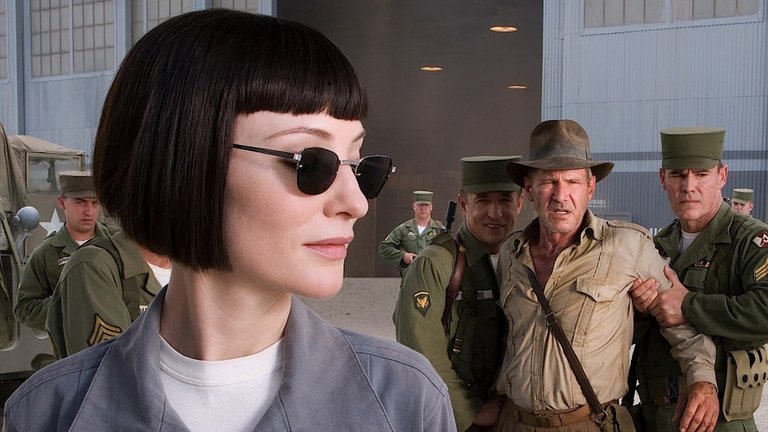
Few films have been awaited with as much hope and fear as the fourth instalment of the Indiana Jones film saga. It was not only about one of the most commercially successful franchises in Hollywood during the 1980s, but also an embodiment of everything that the American film industry can produce at its best, represented by its sovereigns – the producer-director duo Lucas-Spielberg. The film had to be awaited for nineteen years, leading many to assume that the great Hollywood wizards were preparing something truly special due to the long hiatus. On the other hand, Lucas' prequels to Star Wars warned what happens when old masters lose their inspiration after decades-long breaks.
After nearly two decades, Indiana Jones – one of the greatest icons of popular culture from the late 20th century – finally had his new appearance on the big screen at 2008 Cannes Film Festival. The results, at least at first glance, were not particularly impressive – critics were divided, and audiences, after a financially more than decent opening, ultimately preferred Sex and the City a week later.
The two decades during which Harrison Ford, who portrayed the titular role, aged are the reason why the plot of the fourth film setting was moved from 1930s to 1957. With the Cold War raging, adventurous archaeology professor Henry "Indiana" Jones must confront the Soviets, specifically an elite military-intelligence team led by Dr. Irina Spalko (played by Cate Blanchett), a parapsychology expert. The Soviets seek to obtain a crystal skull – an artefact of extraterrestrial origin that conceals the secret of absolute knowledge and is said to grant indescribable powers to whoever returns it to an ancient city in the Peruvian jungle. In his effort to prevent evil communists from taking over the world, Indiana Jones is aided by young and brash motorcycle mechanic Mutt (played by LaBeouf), who struggles to accept that an ageing adventurer represents some form of authority.
Unlike Lucas, who picked up directing for Star Wars after more than two decades away from it, Spielberg has remained continuously active in filmmaking, and his experienced hand is evident in this new Indiana Jones. Although special effects technology has advanced significantly, there is no trace of CGI or trendy MTV-style editing in this film; "Kingdom of the Crystal Skull" stylistically resembles a high-quality product from the 1980s. Spielberg is aided in creating this illusion by his long-time collaborator John Williams, who skilfully recycles Indiana Jones's musical theme – one of the most recognisable in film history.
The narrative flows quickly and smoothly, with a balanced mix of action and humour throughout most of the film. There are numerous historical, cultural, and cinephile references to America in the 1950s, thanks to which Spielberg managed to create an Indiana Jones that is both similar yet different from its three predecessors. Kingdom of the Crystal Skull pays homage to spy thrillers, sci-fi horrors, youth dramas, and other B-movies from the 1950s in much the same way that previous Indiana Jones films did for 1930s film serials.
However, Spielberg's greatest asset is Harrison Ford. Despite being 66 years old, Ford handles this physically not overly demanding role remarkably well without hiding his age; he insisted that Indiana Jones's character in this film be grey-haired. Judging by Kingdom of the Crystal Skull,"Ford could still be called an action star.
On the other hand, one could not say the same for Shia LaBeouf, whose entry was primarily a generational concession to teenagers who have been at the heart of American cinema audiences in recent years and who have long been responsible for the infantilisation of Hollywood blockbusters. His Mutt functions less as a character – who some believed should have be Indiana's successor – and more as a collection of teenage stereotypes from the 1950s.
Cate Blanchett copes far better with stereotypes in her role as a wicked yet fascinating Soviet spy – reminiscent of Rosa Klebb in the classic Bond film From Russia with Love. Other actors were less fortunate with David Koepp's script – this includes Karen Allen, largely forgotten after her first film role as Marion Ravenwood, whose character is dragged by protagonists through the jungle like a sack of stones ; and talented British actor John Hurt whose character mostly stares blankly at the camera.
For many viewers, perhaps most irritating will be the film's closing scene, which feels more suited to a Mexican telenovela than a full-blooded Hollywood blockbuster. Spielberg should perhaps be more criticised for having squandered some of the most effective scenes at the very beginning of the film.
Nevertheless, when all is said and done, Indiana Jones and the Kingdom of the Crystal Skull deserves more than just a passing grade. It is a worthy addition to its franchise and its creators – both old fans and younger audiences will enjoy it. The only discomfort arose from thoughts about a new sequel that may take too long to arrive, a fear, that, judging by the reaction to 2023 Indiana Jones and the Dial of Destiny, was quite justified.
RATING: 7/10 (+++)
Blog in Croatian https://draxblog.com
Blog in English https://draxreview.wordpress.com/
InLeo blog https://inleo.io/@drax.leo
Hiveonboard: https://hiveonboard.com?ref=drax
InLeo: https://inleo.io/signup?referral=drax.leo
Rising Star game: https://www.risingstargame.com?referrer=drax
1Inch: https://1inch.exchange/#/r/0x83823d8CCB74F828148258BB4457642124b1328e
BTC donations: 1EWxiMiP6iiG9rger3NuUSd6HByaxQWafG
ETH donations: 0xB305F144323b99e6f8b1d66f5D7DE78B498C32A7
BCH donations: qpvxw0jax79lhmvlgcldkzpqanf03r9cjv8y6gtmk9